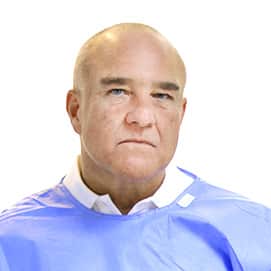About the program
Eye diseases are extremely insidious and pose a hidden danger, because often a person does not notice the initial manifestations of loss of visual field or blindness. With age, the risk of visual impairment increases.
For eye diseases, the principle is especially important: prevention is easier than cure! After all, degenerated sensory cells or a dead area of the retina can no longer be "repaired". Prophylactic diagnostics plays a significant role in preventing visual impairment or incipient blindness.
Severe eye diseases such as glaucoma, age-related macular degeneration, tumors and retinopathy as a consequence of diabetes mellitus are especially frequent in patients over 40 years of age. Therefore, it is this category of patients that is recommended to undergo an annual examination by an ophthalmologist.
Thanks to the development of modern medicine, severe eye diseases diagnosed at an early stage can in many cases be cured.
Program "Ophthalmology"
What is this?
A subjective refractive test is a procedure performed by ophthalmologists to determine a patient's optimal vision correction. During the examination, the specialist makes successive changes in the lenses until he finds those that make the patient’s vision as comfortable and clear as possible. The patient may report preferences and changes in vision throughout the procedure.
For what?
Subjective refraction is important to provide the patient with the best possible vision correction and help him see the world clearly and comfortably. This is especially important for people who experience vision problems such as nearsightedness or farsightedness.
What is this?
Study of the refractive power of the eye using an automatic refractometer and its subsequent computer analysis.
For what?
To determine visual acuity.
What is this?
Functional test using the so-called "Amsler grid".
For what?
The Amsler test is designed to detect degenerative changes in the macula, which may be age-related or a consequence of diabetes, as well as other lesions of the macula.
What is this?
A method of registering changes in the curvature of the lens and assessing the ability of the eye to adapt to the perception of objects located at different distances from it.
For what?
To assess the focusing ability of the eyes, to diagnose accommodation disorders (myopia, hypermetropia, presbyopia), astigmatism.
What is this?
Examination of the eye through a biomicroscope using a gonioscope.
For what?
It is used to diagnose glaucoma and clarify the cause of impaired intraocular fluid outflow, identify pathological changes, newly formed vessels, tumors, to exclude foreign bodies and damage to the structures of the anterior chamber angle.
What is this?
Analysis of the deformation of the cornea resulting from the reflection of an air wave. The examination is carried out with a special device - a tonometer - without touching the eyeball.
For what?
To assess the hydrodynamics of the eye - the level of intraocular pressure, the coefficient of ease of outflow, the rate of production of intraocular fluid, to monitor the effectiveness of treatment.
What is this?
Examination of the fundus. Drops (mydriatics) are used to dilate the pupil in order to increase the field of examination of the fundus.
For what?
To assess the condition of the retina, optic disc, macular area and fundus vessels.
What is this?
Method for measuring the thickness of the cornea using ultrasound.
For what?
For the diagnosis of foreign bodies, tumors, the degree of edema or reduction in the thickness of the cornea, in preparation for surgery and for postoperative control.
What is this?
Method for determining the size of the eyeball.
For what?
For the diagnosis of foreign bodies, tumors, for assessing the state of the structures of the eyeball, in preparation for surgical interventions and for postoperative control.
What is this?
Measurement of corneal surface parameters, its curvature and dimensions
For what?
For the diagnosis of pathological changes in the cornea - keratoconus (conical protrusion of the cornea), as well as keratoglobus (spherical protrusion of the cornea), leading to visual impairment.
What is this?
A method for studying visual fields using an automated perimeter with computer programs.
For what?
To determine the boundaries of the visual fields and identify their defects in order to diagnose pathological conditions of the retina and optic nerve.
What is this?
The study of vision by excluding one eye from the process of binocular vision.
For what?
To detect a violation of the parallelism of the visual axes of the eyes, which can lead to loss of binocular vision (vision with both eyes at once).
What is this?
Examination of the state of the retina and optic nerve using a laser beam.
For what?
Provides diagnostics of pathological changes in the retina, macular rupture, epiretinal membrane, senile macular degeneration, macular edema, glaucoma, lesions of the optic nerve and other diseases.
What is this?
Computer analysis of the refractive power and curvature of the cornea.
For what?
Examination is necessary in preparation for refractive surgery, for the diagnosis of irregular astigmatism, dystrophy, thinning, scarring and deformation of the cornea.
What is this?
This is an examination in which the surface of the retina is scanned with a laser beam and a three-dimensional image of its surface is built using a computer.
For what?
To assess the condition and progression of excavation of the optic nerve head, the center of the retina, the macula, the diagnosis of retinal diseases, the observation of patients with glaucoma.
What is this?
This diagnostic method involves injecting a special contrast agent into a patient's vein and then photographing the retina using a specialized fluorescent camera, which allows the distribution of the contrast agent throughout the retinal vessels to be tracked in real time.
For what?
Retinal fluorescein angiography is used to diagnose and monitor various eye diseases, such as diabetic retinopathy, wet age-related macular degeneration and other pathologies that affect the blood supply to the retina. This method allows ophthalmologists to assess the condition of blood vessels, identify vascular changes, as well as vessel density and capillary refill time, which is necessary to develop a treatment plan.
Program "Ophthalmology"
Duration: 1 day
















